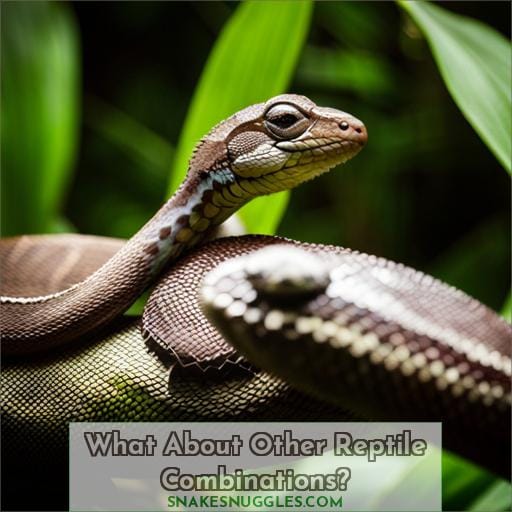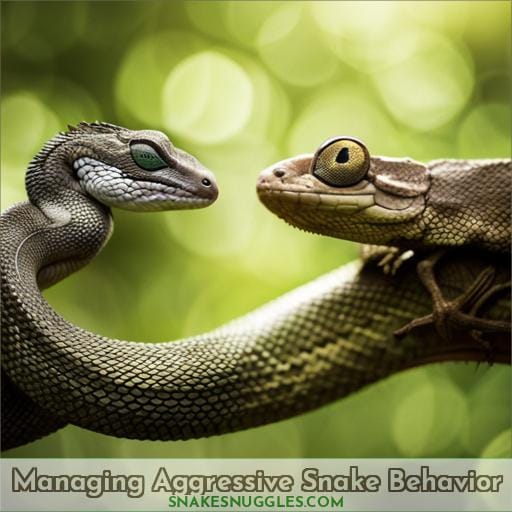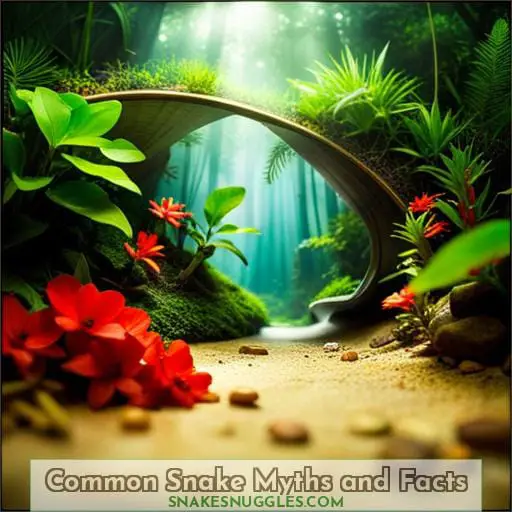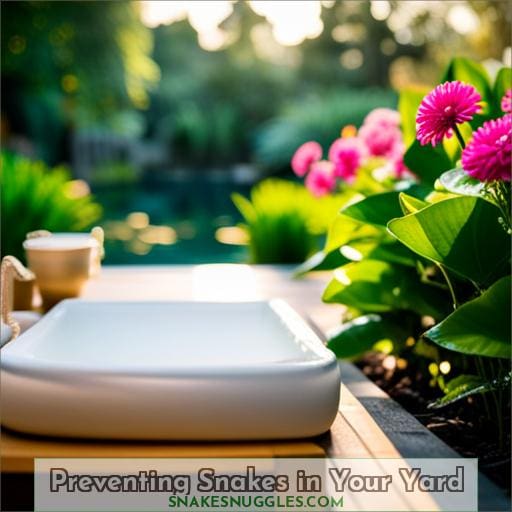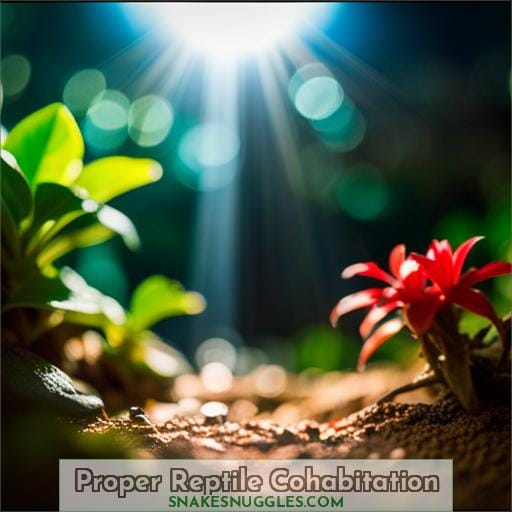This site is supported by our readers. We may earn a commission, at no cost to you, if you purchase through links.

Their habitats differ, and one poses a genuine threat to the other.
Can they coexist?
Discover the truth here, delving into the intricacies of reptile habitats, safety concerns, and expert tips for harmonious reptile cohabitation.
Table Of Contents
- Key Takeaways
- Can Snakes and Lizards Coexist?
- What About Other Reptile Combinations?
- Managing Aggressive Snake Behavior
- Common Snake Myths and Facts
- Preventing Snakes in Your Yard
- Proper Reptile Cohabitation
- Frequently Asked Questions (FAQs)
- What types of snakes and lizards get along the best?
- How often do I need to clean the habitat if I keep snakes and lizards together?
- What signals show that a snake or lizard is stressed from living together?
- Can a professional snake handler help me introduce snakes and lizards safely?
- Are there any legal issues with housing snakes and lizards together in my area?
- Conclusion
Key Takeaways
Snakes and lizards have incompatible habitat needs, such as temperature and humidity preferences.
Lizards are at risk of becoming prey for carnivorous snakes. Partitioning their habitat cannot fully prevent dangerous interactions.
Proper enclosures should be tailored to each species’ individual needs for things like warmth and humidity levels.
Cohabitation enables frequent contact between snakes and lizards, which contributes to predatory behaviors, aggression and potential harm or mortality.
Can Snakes and Lizards Coexist?
Unfortunately, snakes and lizards generally cannot safely coexist in the same habitat.
These reptiles have vastly different environmental needs that would be difficult to meet in a shared space.
Specifically, snakes require warmer temperatures and lower humidity, while lizards need cooler temperatures and higher humidity.
Housing them together risks the health and safety of both animals.
Different Habitat Needs
With reptile cohabitation, you’d do well to recognize that snakes and lizards have markedly different habitat needs that make their coexistence challenging.
Lizards thrive in warmer, drier spaces while snakes prefer cooler, more humid environments.
This temperature disparity leads to compatibility issues, posing environmental risks and likelihood of behavioral conflicts.
Considering such habitat separation necessities, cohabitating snakes and lizards risks their health and wellbeing.
By understanding the specific needs of each species regarding ideal temperatures and humidity, you can provide proper habitats tailored to enable them to thrive.
Risk of Predation
Given snakes’ carnivorous diets, housing them with lizards risks predation, potentially resulting in severe injury or death.
Snakes view lizards as prey due to evolutionary predator/prey dynamics.
Lizards lack appropriate defenses against snake attacks.
Cohabitation enables frequent contact and stimulation of predatory behaviors.
Partitioning the habitat can’t prevent all interactions.
Either animal may experience significant harm or mortality.
What About Other Reptile Combinations?
Considering other reptile combinations, you’d want to research species compatibility before attempting any reptile community.
When housing multiple reptile species, carefully consider factors like climatic temperature preferences, habitat needs, and natural behaviors to prevent conflict.
For instance, certain lizard species may be compatible if they require similar basking temperatures, while a tortoise would likely be stressed by a snake’s presence.
Additionally, having only one male of territorial species helps prevent dominance issues over resources like heat, food, and mates.
Regularly monitor for signs of aggression or stress.
With proper preventive measures and habitat considerations, some reptiles can safely coexist.
| Species 1 | Species 2 | Compatibility |
|---|---|---|
| Bearded Dragon | Leopard Gecko | Moderate |
| Chameleon | Anole | Low |
| Tortoise | Snake | Very Low |
Managing Aggressive Snake Behavior
- Assign one person for every four feet of an aggressive snake to ensure control when handling the situation.
Approach the snake calmly and confidently, moving slowly to avoid startling it.
Wear thick gloves and have a snake hook ready to direct the snake’s head away from you if needed.
Quickly but gently restrict the snake’s movement by supporting its body weight while another handler secures the head.
To calm an aggressive snake, provide enrichment through habitat modifications, scent and texture variations, increased climbing opportunities, puzzle feeders, and stimulus control training with positive reinforcement.
Work patiently with the snake daily, rewarding non-aggressive behaviors.
Seek professional advice from a qualified herpetologist or animal behaviorist for handling aggression rooted in dominance, disease, or feeding issues.
Providing snakes exhibiting dangerous behaviors with proper care and training promotes safe human-snake interactions.
Common Snake Myths and Facts
Unfortunately, snakes and lizards cannot safely coexist due to their differing habitat and dietary needs.
While some common myths persist that certain techniques can enable cohabitation, extensive research shows that keeping these species together poses serious risks.
We must provide proper enclosures tailored to each animal’s specific requirements in line with expert guidelines on reptile care and welfare.
Milk and Snakes
Although managing aggressive snakes requires special precautions, you’re likely familiar with some common snake myths—for example, milk won’t actually attract snakes to your yard.
The myth that milk attracts snakes likely stems from snakes being drawn to rodents that consume dairy products.
Snakes don’t drink milk at any life stage, as they’re strictly carnivorous reptiles.
Offering milk to snakes can cause digestive issues, illness, and even death.
Habitat management through exclusion of rodent food sources is the best way to deter snakes.
Snake Myths Vs Facts
Five of the most common snake myths you may have heard actually have no basis in fact.
Snakes don’t always travel in pairs nor dislocate jaws while feeding, and they aren’t deaf or poisonous.
Fascinating realities are that snakes are venomous, not poisonous, and they kill prey by preventing blood circulation rather than squeezing them.
When debunking beliefs about snakes through fact checks, we uncover captivating truths about these mythic creatures.
Preventing Snakes in Your Yard
Controlling snakes in your backyard starts with eliminating places for them to hide and things for them to eat.
Start by removing any piles of wood, rocks, leaves, or debris that snakes could use as shelter.
Also get rid of any standing water sources, as snakes are attracted to places to drink and find prey.
Modify your landscaping by keeping grass short, filling in holes, and pruning vegetation back from the home’s foundation.
Implement rodent control measures like sealing up cracks and crevices where they can enter, removing pet food at night, and using humane traps.
You can make DIY snake barriers using hardware cloth to seal off entry points.
Natural snake repellents like ammonia-soaked rags or predator urine also deter snakes without chemicals.
With some habitat modification and exclusion techniques, you can humanely and safely snake-proof your yard.
Proper Reptile Cohabitation
You’d rarely combine different species of reptiles in an enclosure unless you’ve thoroughly researched their compatibility and provided each animal proper care tailored to its specific needs.
Evaluate temperature and humidity preferences for each species. For example, snakes thrive in warmer and drier habitats than aquatic turtles.
Consider gender dynamics. House only one male of territorial species to prevent conflict.
Prevent disease transmission between reptiles by quarantining new additions for at least 30-60 days.
When assembling a reptile community, prioritize the wellbeing of each animal above your own interests. Provide adequate space and specialized heating/lighting so every reptile can thermoregulate properly.
Continuously monitor for signs of stress or aggression, and immediately separate any incompatible animals.
Although interspecies cohabitation can s쳮d with diligent oversight, the simplest solution is housing each reptile separately based on its individual requirements.
Handling aggressive snakes demands additional caution – use hooks/tongs, enlist assistance, and put safety first.
Frequently Asked Questions (FAQs)
What types of snakes and lizards get along the best?
Unfortunately, snakes and lizards shouldn’t be housed together.
Due to their vastly different habitat requirements, attempting to keep them in the same enclosure risks serious harm.
For their health and safety, they’re best cared for separately.
How often do I need to clean the habitat if I keep snakes and lizards together?
I can’t recommend keeping snakes and lizards together.
Their needs differ too greatly, risking the health and safety of both.
Please consider separate enclosures for these animals.
What signals show that a snake or lizard is stressed from living together?
Unfortunately, housing snakes and lizards together risks serious harm.
I advise separate, species-appropriate enclosures to meet their distinct needs and ensure good health.
Can a professional snake handler help me introduce snakes and lizards safely?
Unfortunately, no professional handler can safely introduce snakes and lizards in captivity.
Their needs differ too greatly.
Focus on providing excellent care for whichever species you keep.
Their wellbeing must come first.
Are there any legal issues with housing snakes and lizards together in my area?
Depends on the locality.
Research your city’s exotic pet ordinances.
Some restrict certain species and housing arrangements.
Prioritize animal welfare over convenience or preference.
Improper cohabitation risks health issues.
Conclusion
So, y’all see, reptiles deserve empathy too.
Their needs may seem trivial to us, but ensuring snake and lizard safety starts with understanding.
When habitats harmonize, these scaly cuties can thrive side-by-side.
Though occasional squabbles occur, some common sense precautions allow peaceful coexistence for all.
Because in the end, can’t we share this earth with creatures great and small?
After all, it’s the only one we’ve got.
Now go make some reptile friends!


